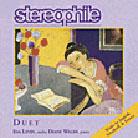December 1998
This superlative recording is done to Stereophile's usual exacting recording standards and features 24-bit resolution to preserve the original impact and detail of the performances as well as the outstanding ambient qualities of the recording venues. Duet is the ninth recording released by Stereophile since 1989, excluding their three test CDs, and all of them have become staples for audiophiles all over the world. There are two recording venues here, both located in Santa Fe, New Mexico. The Janácek and Enescu works were recorded at St. Francis Auditorium, Museum of Fine Arts, and the Schulhoff sonata was recorded at the beautiful Loretto Chapel. The notes from the instruments, especially those from the violin recorded in the Loretto Chapel, have been masterfully captured through the employment of some of the finest recording technology available. The character of the notes seems to resonate and reverberate in the air with a quality that is analogous to the warm glow of a southwestern sunset lingering long after the sun has descended beyond the horizon. The Janácek and Enescu works are played by Walsh on a concert-quality nine-foot New York Steinway D piano. Each of the two venues has a distinctly different sonic signature, and both are effortlessly reproduced in my listening room. While the Loretto Chapel is warm, reverberant and lush, the St. Francis Auditorium is light and airy, providing the music with more bloom. In both cases, however, the venues complement the musical character of the instruments and the pieces, and add to the enjoyment of the overall listening experience. When reproducing the sound of a piano, many recordings, particularly of chamber music or of small ensembles, give the instrument a disturbing larger-than-life quality which tends to overbear the other instruments. On this recording, the Steinway is center stage, and only center stage, with the violin perhaps six to eight feet to the right. The piano is rendered dimensionally accurate in the soundspace, and is a pleasure to behold. Aside from being a technical tour de-force, the music on Duet is rendered with such unbridled emotion that one cannot help being drawn into the whole experience for the entire 54-minute duration of the disc. Whether alone during the Schulhoff sonata or while performing the accompanied Janácek and Enescu works, Levin coaxes the notes from her violin with fury, passion and sensitivity. Hers is a virtuoso performance that will delight anyone who loves the sweet emotion that only the finest musicians can draw from inside the body of this wonderful instrument. Walsh plays the piano with a sense of timing and power. Whether it is the clean, lightning-fast meandering on the keys with the lightest of touches or her powerful intense chromatic bursts, Walsh’s style is intensely musical. Together on this recording, these two musicians have produced a collection that is greater than the sum of its parts. From musical and technical perspectives, Duet is a winner. I have heard all of Stereophile‘s recordings, and each one is excellent. In the case of Duet, however, John Atkinson and Wes Phillips may have outdone themselves. GO BACK TO: |
 Duet
Duet![[Reviewed on CD]](../format/regcd.gif) Duet
is Stereophile's newest release and features the dynamic works of three Eastern
European composers: Janácek, Schulhoff and Enescu. All of the pieces originate from the
period between World Wars I and II. Moved by the emotional desperation and physical
devastation caused by war, composers flourished during these years, yielding powerfully
expressive works.
Duet
is Stereophile's newest release and features the dynamic works of three Eastern
European composers: Janácek, Schulhoff and Enescu. All of the pieces originate from the
period between World Wars I and II. Moved by the emotional desperation and physical
devastation caused by war, composers flourished during these years, yielding powerfully
expressive works.